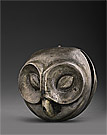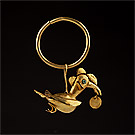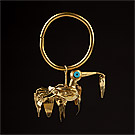Exhibition themes Early cultures-Paracas,Vicús,Frías Style,Recuay
Paracas art and religion were influenced by the Chavín cult. From the 1920s scientific excavations took place in the Paracas Peninsula on the south coast. Archaeologists found brilliant and intricate textiles buried in caverns hollowed out in the cliffs. Large mummy bundles were wrapped around seated corpses, their limbs bound and knees folded against their chins. Hundreds of layers of embroidered textiles—such as cloaks, mantles, tunics, and headdresses—survived. They were made of alpaca and llama wool from the distant highlands.
Isolated in the northern Piura Valley, Vicús craftsmen are famous for their skill in metallurgy, especially gilded copper. Regalia ranges from beautifully simple forms to dazzling pendant-covered body ornaments. The culture eventually succumbed to the invading Moche. The related Frías style describes a group of works looted from Alto Piura in modern times. Characteristic objects were made from twisted wire and sheet gold, sometimes inlaid with platinum.
Recuay culture arose in the area now known as Ancash in the northern highlands. Their traditions include distinctive white and red ceramics, carved stone sculpture and architecture in which female as well as male nobles, priests and warriors are often depicted.














